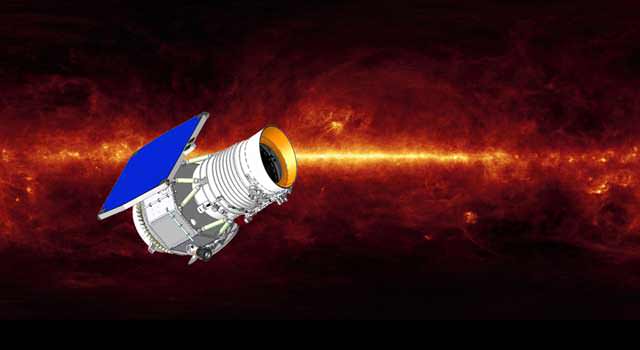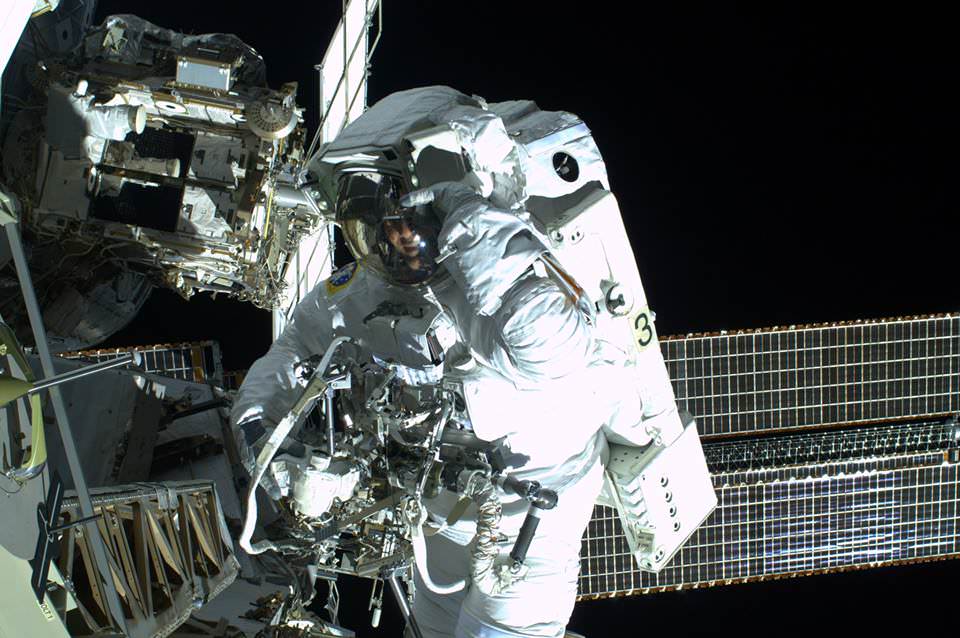A simple, yet elegant method of measuring the surface gravity of a star has just been discovered. These computations are important because they reveal stellar physical properties and evolutionary state – and that’s not all. The technique works equally well for estimating the size of hundreds of exoplanets. Developed by a team of astronomers and headed by Vanderbilt Professor of Physics and Astronomy, Keivan Stassun, this new technique measures a star’s “flicker”. Continue reading “Flicker… A Bright New Method of Measuring Stellar Surface Gravity”
Curiosity Conducts Science on the Go and Zooms to Stunning Mount Sharp
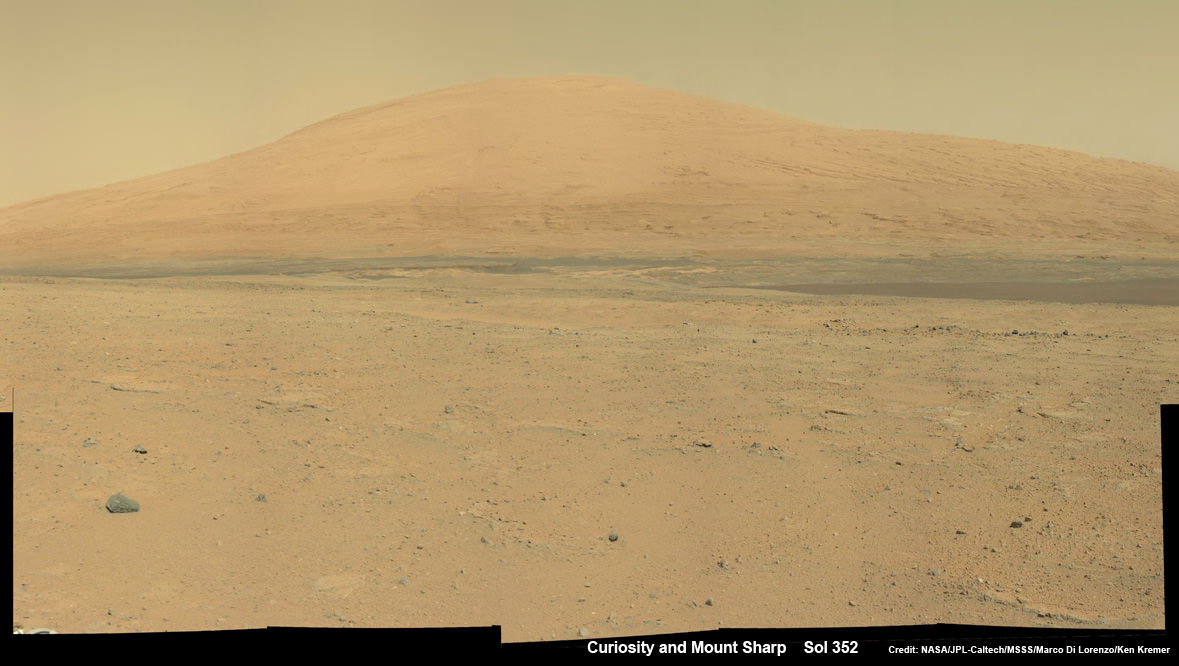
Curiosity Spies Mount Sharp – her primary destination. Curiosity will ascend mysterious Mount Sharp and investigate the sedimentary layers searching for clues to the history and habitability of the Red Planet over billions of years. But first she must safely trespass through the treacherous dark dunes fields. This mosaic was assembled from over 2 dozen Mastcam camera images taken on Sol 352 (Aug 2, 2013). Credit: NASA/JPL-Caltech/MSSS/ Marco Di Lorenzo/Ken Kremer
See the full mosaic below [/caption]
It’s never a dull moment for NASA’s Curiosity rover at T Plus 1 Year since touchdown on the Red Planet and T Minus 1 year to arriving at her primary target, the huge mountain overwhelming the center of the landing site inside Gale Crater.
Curiosity is literally and figuratively zooming in on stunningly beautiful and mysterious Mount Sharp (see our new mosaics above/below), her ultimate destination, while conducting ‘Science on the Go’ with her duo of chemistry labs – SAM and CheMin – and 8 other science instruments as she passes the 2 kilometer driving milestone today; Aug 20 !
“We are holding samples for drops to ChemMin and SAM when the science team is ready for it,” Jim Erickson, Curiosity Project Manager of NASA’s Jet Propulsion Laboratory (JPL), told Universe Today in an exclusive interview.
“Curiosity has landed in an ancient river or lake bed on Mars,” Jim Green, Director of NASA’s Planetary Science Division, told Universe Today.
So, those samples were altered by liquid Martian water – a prerequisite for life.

Credit: NASA/JPL-Caltech/MSSS/ Marco Di Lorenzo/Ken Kremer-kenkremer.com
In fact the car sized rover has saved samples from both the ‘John Klein’ and ‘Cumberland’ drill sites collected previously in the ‘Yellowknife Bay’ area for analysis by the miniaturized labs in the rovers belly -when the time is right.
“Curiosity has stored a Cumberland sample and still has a John Klein sample on board for future use,” Erickson explained.
And that time has now arrived!
“We have put a sample from the Cumberland drill hole into SAM for more isotopic measurements,” reported science team member John Bridges in a blog update on Sol 363, Aug. 14, 2013.
“The sample had been cached within the robotic arm’s turret.”
Curiosity is multitasking – conducting increasingly frequent traverses across the relatively smooth floor of Gale Crater while running research experiments for her science handlers back here on Earth.

She’s captured stunning new views of Mount Sharp – rising 5 km (3 miles) high into the sky – and movies of Mars tiny pair of transiting moons while ingesting new portions of the drilled rock samples acquired earlier this year.
Here’s our video compilation of Phobos and Deimos transiting on Aug 1, 2013
Video caption: Transit of Phobos in front of Deimos, taken by MSL right MastCam imager on Sol 351 around 3:12 AM local time (Aug 1, 2013, 8:42 UTC); 16 original frames + 14 interpolated (5x speed-up). Credit: NASA/JPL-Caltech/MSSS/ Marco Di Lorenzo/Ken Kremer
The sample analysis is still in progress.
“The SAM data have not all been received yet,” wrote science team member Ken Herkenhoff in a blog update.
Earlier analysis of sample portions from both ‘John Klein’ and ‘Cumberland’ revealed that the Yellowknife Bay area on Mars possesses the key mineral ingredients proving that Red Planet was once habitable and could have sustained simple microbial life forms.
The scientists are seeking further evidence and have yet to detect organic molecules – which are the building blocks of life as we know it.
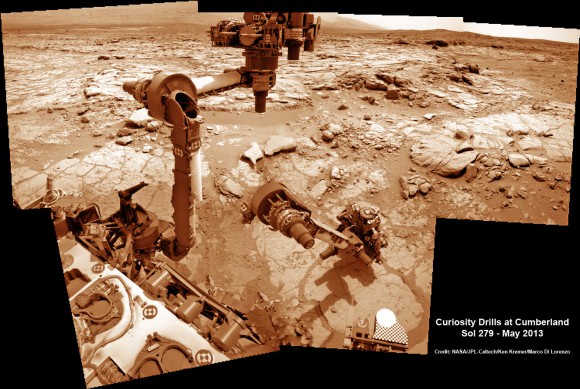
Yellowknife Bay resembles a dried out river bed where liquid water once flowed eons ago when the Red Planet was far warmer and wetter than today.
As the 1 ton robot ascends Mount Sharp, she will examine sedimentary layers layed down on ancient Mars over hundreds of millions and perhaps billions of years of past history and habitability.
And just as the rover was celebrating 1 year on Mars on Aug 5/6, she found an intriguing sand dune on Sol 354. See our mosaic
“The rover paused to take images of its tracks after crossing a windblown ripple,” Herkenhoff reported.
As the six wheeled rover approaches Mount Sharp over the next year, she will eventually encounter increasing treacherous dunes that she must cross before beginning her mountain climbing foray.
As of today, Sol 369 (Aug. 20) Curiosity has broken through the 2 kilometer driving mark with a new 70 meter drive, snapped over 75,000 images and fired over 75,000 laser shots.
Mount Sharp is about 8 kilometers (5 miles) distant as the Martian crow flies.
How long will the journey to Mount Sharp require?
“Perhaps about a year,” Erickson told me. “We are trying to make that significantly faster by bringing autonav [autonomous navigation software] online.”
“That will help. But how much it helps really depends on the terrain.”
So far so good.
Meanwhile NASA’s next Mars orbiter called MAVEN (for Mars Atmosphere and Volatile Evolution), recently arrived at the Kennedy Space Center after a cross country flight.
Kennedy technicians are completing assembly and check out preparations for MAVEN’s blastoff to the Red Planet on Nov. 18 from Florida atop an Atlas V rocket similar to the one that launched Curiosity nearly 2 years ago.
And I’ll be at Kennedy to report up close on MAVEN’s launch.
Stay tuned.
WISE Spacecraft Re-Activated to Hunt for Potentially Hazardous Asteroids
A hibernating spacecraft has been called back into service. The WISE (Wide-field Infrared Survey Explorer”) spacecraft that has been sleeping in a polar orbit around Earth for two years will be turned back on next month to hunt for more potentially hazardous asteroids, and perhaps search for an asteroid that NASA could capture and explore in the future.
“The WISE mission achieved its mission’s goals and as NEOWISE extended the science even further in its survey of asteroids. NASA is now extending that record of success, which will enhance our ability to find potentially hazardous asteroids, and support the new asteroid initiative,” said John Grunsfeld, NASA’s associate administrator for science. “Reactivating WISE is an excellent example of how we are leveraging existing capabilities across the agency to achieve our goal.”
WISE originally was launched in December 2009 and scanned the entire celestial sky in infrared light about 1.5 times, searching for the coolest stars, the universe’s most luminous galaxies and some of the darkest near-Earth asteroids and comets. It captured more than 2.7 million images of objects in space, ranging from faraway galaxies to asteroids and comets close to Earth.
However, in early October 2010, after completing its prime science mission, the spacecraft ran out of the frozen coolant that keeps its instrumentation cold. But two of its four infrared cameras remained operational, which were still optimal for asteroid hunting, so NASA extended the NEOWISE portion of the WISE mission by four months, with the primary purpose of hunting for more asteroids and comets, and to finish one complete scan of the main asteroid belt.
The NEOWISE mission completed a full sweep of the main asteroid belt, and during 2010, NEOWISE observed about 158,000 rocky bodies out of approximately 600,000 known objects. Discoveries included 21 comets, more than 34,000 asteroids in the main belt between Mars and Jupiter, and 135 near-Earth objects.
“The data collected by NEOWISE two years ago have proven to be a gold mine for the discovery and characterization of the NEO population,” said Lindley Johnson, NASA’s NEOWISE program executive in Washington. “It is important that we accumulate as much of this type of data as possible while the WISE spacecraft remains a viable asset.”
Now WISE will again search for asteroids with a new extra-extended three year mission to search for more PHAs as well as suitable asteroids for future human exploration missions.
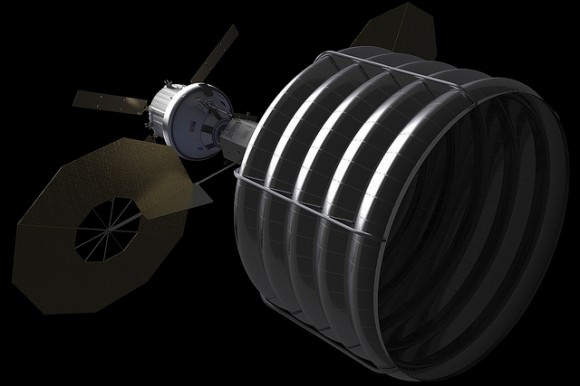
NASA said they anticipate WISE will use its 16-inch (40-centimeter) telescope and infrared cameras to discover about 150 previously unknown NEOs and characterize the size, albedo and thermal properties of about 2,000 others — including some of which could be candidates for the agency’s recently announced asteroid initiative.
“The team is ready and after a quick checkout, we’re going to hit the ground running,” said Amy Mainzer, NEOWISE principal investigator at NASA’s Jet Propulsion Laboratory in Pasadena, Calif. “NEOWISE not only gives us a better understanding of the asteroids and comets we study directly, but it will help us refine our concepts and mission operation plans for future, space-based near-Earth object cataloging missions.”
Source: NASA
Now’s Your Big Chance To Use NASA’s Shuttle Launcher Platforms
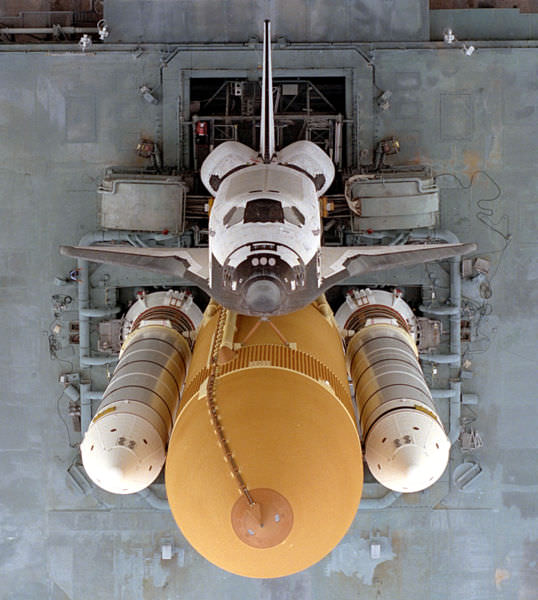
If you’ve got a new use for the mobile launcher platforms NASA used for the shuttle program, the agency is all ears.
NASA invited government and commercial entities to submit their ideas for the platforms, which used to ferry the space shuttles and the Apollo rockets from the Vehicle Assembly Building to their launch pads.
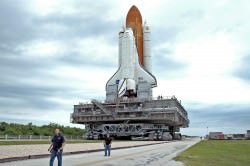
The ideal for NASA is to make them available for commercial launch activity. “Interested parties are requested to provide the following … estimated annual launch manifest, plans for retrofitting, storing, transporting, estimated schedule for acquiring use of the MLP(s), and the length of time the MLP(s) would be required for a particular activity,” the agency stated in a request for information.
Other options for the platforms could include modifying them for use in oil rigs, artificial reefs or even museum exhibits. Deconstruction is also being considered.
Each of the three platforms is two storeys tall, weigh 8.2 million pounds, with a platform of about 160 feet by 135 feet.
Responses are due Sept. 6 and you can check out the RFI here.
Earthlings Wave at Saturn as Cassini Images Us
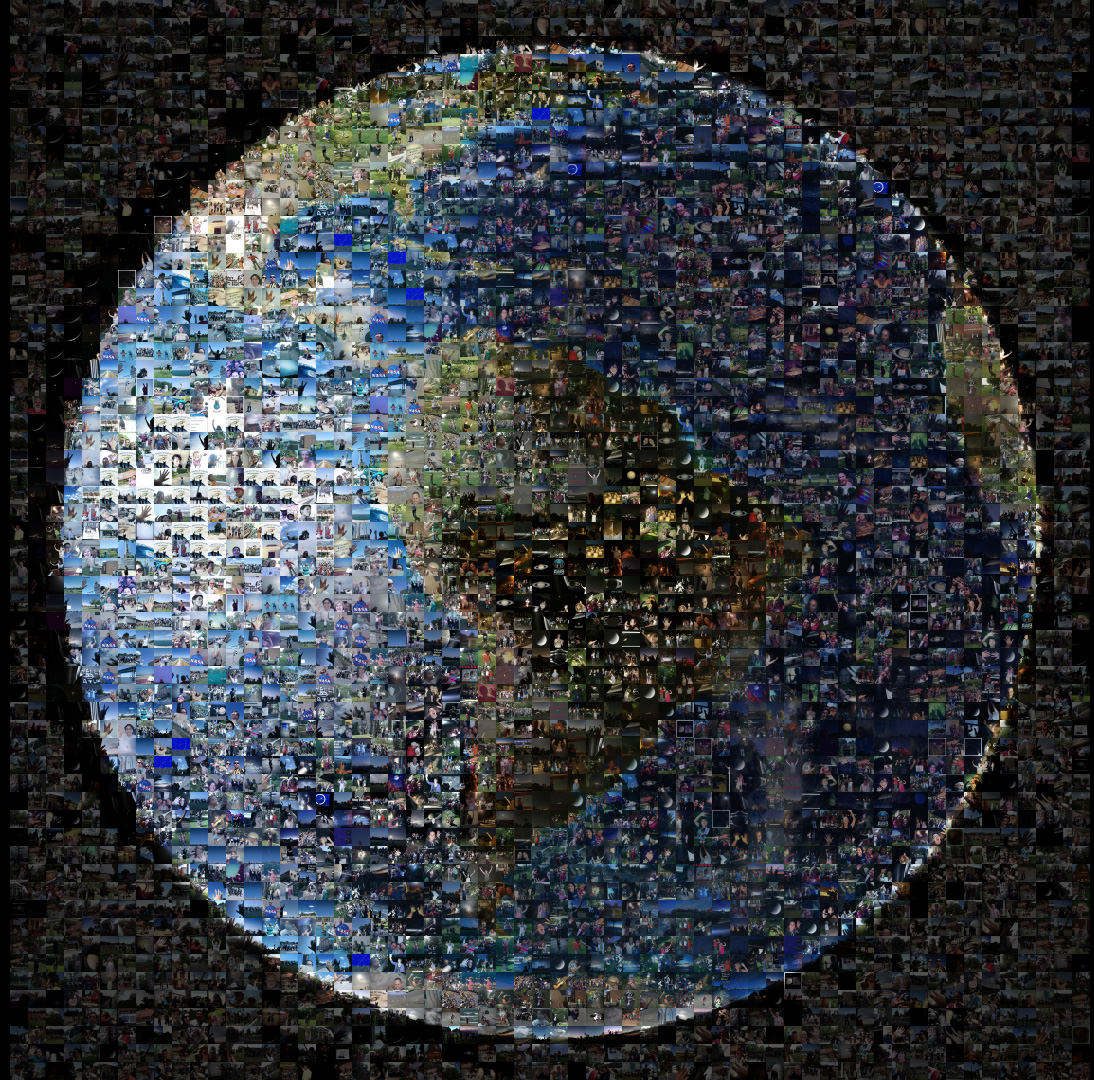
Earth Waves at Saturn and Cassini on July 19, 2013
From more than 40 countries and 30 U.S. states, people around the world shared more than 1,400 images of themselves as part of the Wave at Saturn event organized by NASA’s Cassini mission on July 19, 2013. The Cassini team created this image collage as a tribute to the people of Earth
Credit: NASA/JPL-Caltech/People of Earth
See link below to the absolutely gigantic full resolution version [/caption]
On July 19, millions of Earthlings worldwide participated in NASA’s ‘Wave at Saturn’ campaign as the NASA Cassini Saturn orbiter turned about and imaged all of us.
Earthlings from 40 countries and 30 U.S. states heeded NASA’s call to photograph themselves while smiling and waving at Saturn and Cassini across 1 billion miles of interplanetary space and shared over 1400 images.
The results of all those images has now been assembled into a fabulous collage in the shape of our planet and released today (Aug. 21) by NASA and the Cassini team as a tribute to the People of Earth.
“Did you wave at Saturn and send us your photo? Then here’s looking at you!” NASA announced on the Cassini Facebook page.
This event was the first time that the citizens of Earth knew in advance that a distant interplanetary spacecraft was photographing portraits of our home planet and our Moon. NASA invited everyone to participate.
Photos flooded into NASA via Twitter, Facebook, Flickr, Instagram, Google+ and email.
Click here for the full resolution version. But be forewarned – it weighs in at over 26 MB and it’s far too big to post here.
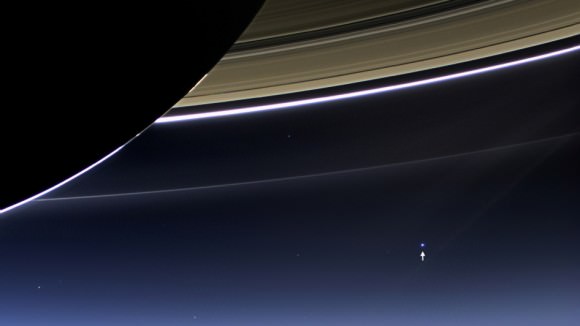
In this rare image taken on July 19, 2013, the wide-angle camera on NASA’s Cassini spacecraft has captured Saturn’s rings and our planet Earth and its moon in the same frame. Image Credit: NASA/JPL-Caltech/Space Science Institute
“Thanks to all of you, near and far, old and young, who joined the Cassini mission in marking the first time inhabitants of Earth had advance notice that our picture was being taken from interplanetary distances,” said Linda Spilker, Cassini project scientist at NASA’s Jet Propulsion Laboratory, Pasadena, Calif, in a statement.
“While Earth is too small in the images Cassini obtained to distinguish any individual human beings, the mission has put together this collage so that we can celebrate all your waving hands, uplifted paws, smiling faces and artwork.”
The Cassini imaging science team is still assembling the hundreds of images of Saturn and Earth snapped by the spacecraft as we were waving, to create individual color composites and a panoramic view of the ‘pale blue dot’ and the entire Saturnian system.
To capture all of Saturn and its wide swath of rings, Cassini’s wide angle camera snapped a mosaic of 33 footprints on July 19, 2013.
“At each footprint, images were taken in different spectral filters for a total of 323 images,” says Carolyn Porco, Cassini Imaging Team leader, Space Science Institute in Boulder, Colo.
Cassini took the pictures of Earth from a distance of about 898 million miles (1.44 billion kilometers) away from the home to every human being that has ever lived.
Here is our partial version of Cassini’s mosaic.

Cassini was launched from Florida in 1997.
It achieved orbit at Saturn in 2004 and has transmitted breathtaking images and science that revolutionized our understanding of the Saturnian system.
The mission is scheduled to continue until 2017 when it will commit a suicide death dive into the humongous gas giant.
Coincidentally, the first humans (Neil Armstrong and Buzz Aldrin) set foot on the Moon 44 years ago nearly to the day of Cassini’s Earth-Moon portrait on July 20, 1969 aboard Apollo 11.
And likewise on July 19, 2013, billionaire space enthusiast Jeff Bezos announced that his dive teams had recovered components of an Apollo 11 first stage F-1 rocket engine from the Saturn V moon rocket that propelled the first humans to the Moon.
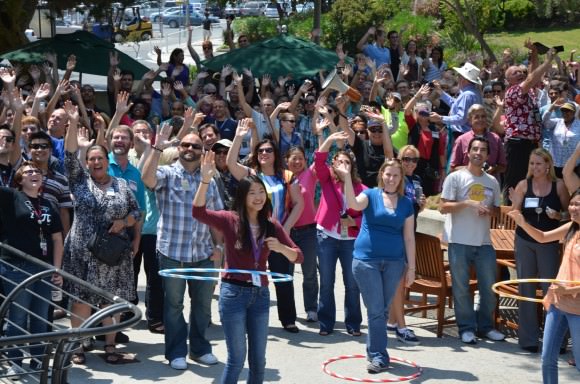
Timelapse: Noctilucent Clouds and Aurora Together in the Sky
Just in case you haven’t seen this bit of awesome yet: Noctilucent clouds and aurora showed up together in skies over Scotland on the night of August 4/5, 2013. Maciej Winiarczyk from the Caithness Astronomy Group was on hand to capture it.
Enjoy!
Geek Out! How to Build Your Own Nova Delphini Light Curve
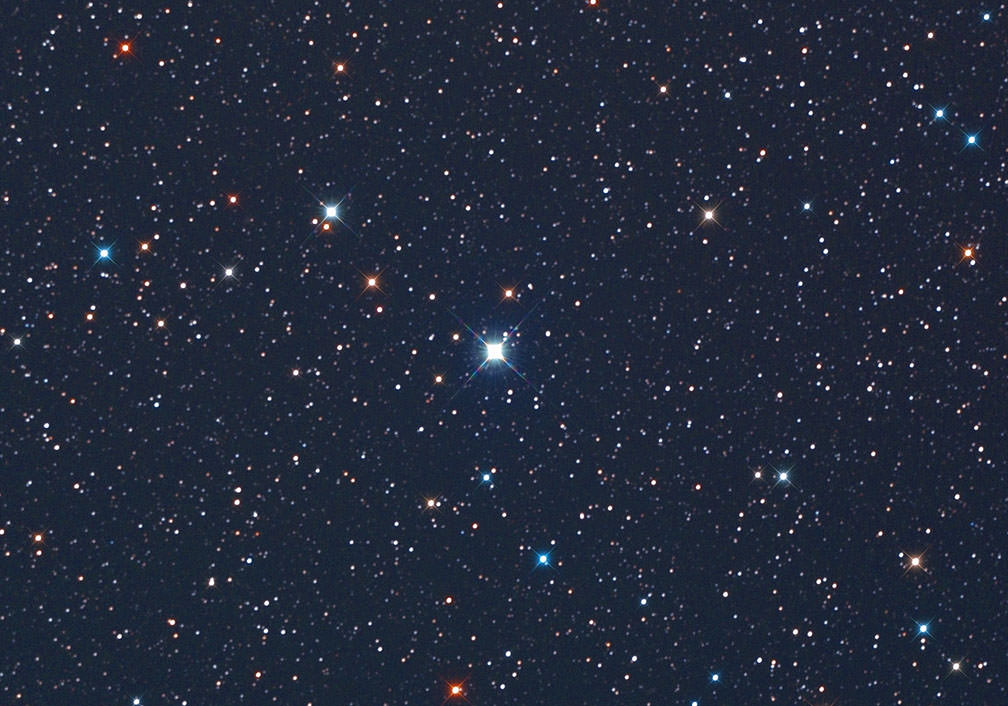
And now for something to appeal to your inner geek. Or, if you’re like me, your outer geek. Many of you have been watching the new nova in Delphinus with the naked eye and binoculars since it burst onto the scene early Aug. 14. In a moment I’ll show how to turn your observations into a cool representation of the nova’s behavior over time.
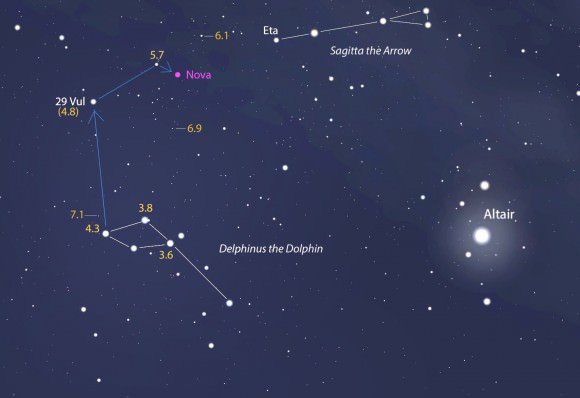
Where I live in northern Minnesota, we’ve had a lucky run of clear nights since the outburst began. Each night I’ve gone out with my 8×40 binoculars and star chart to estimate the nova’s brightness. The procedure is easy and straightforward. You find comparison stars near the nova with known magnitudes, then select one a little brighter and one a little fainter and interpolate between the two to arrive at the nova’s magnitude.
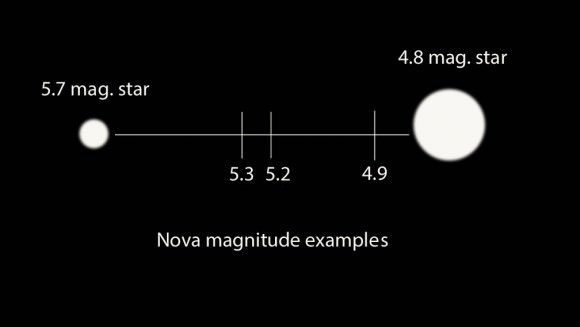
For example, if the nova’s brightness lies halfway between the magnitude 4.8 and 5.7 stars it’s about magnitude 5.3. The next night you might notice it’s not exactly halfway but a tad brighter or closer to the 4.8 star. Then you’d measure 5.2. Remember that the smaller the number, the brighter the object. I’ve found that defocusing the stars into disks makes it a bit easier to estimate these differences.
In time, you’ll come up with a list of magnitudes or brightness estimates for Nova Delphini. Here’s mine to date:
* Aug. 14: 5.8
* Aug. 15: 4.9
* Aug. 16: 5.0
* Aug. 17: 5.0
* Aug. 18: 5.0
* Aug. 19: 5.2
* Aug. 20: 5.5
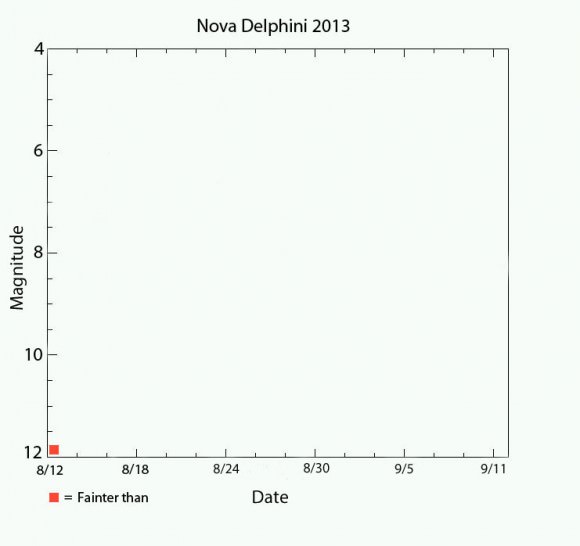
So far just numbers, but there’s a way to turn this into a satisfying visual picture of the nova’s long-term behavior. Graph it! That’s what astronomers do, and they call it a light curve.
I dug around and came up with this very basic template. The horizontal or x-axis measures time in days, the vertical or y-axis plots the nova’s brightness measured in magnitudes. You can either right-click and save the image above or grab the higher-res version HERE.
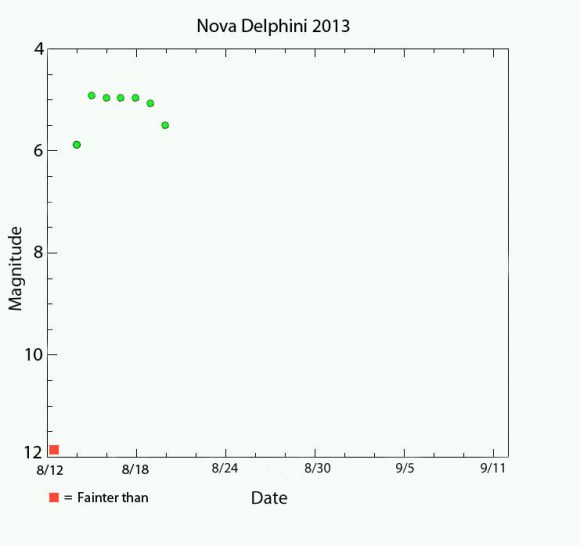
Next, print out a copy and lay in your data points with pencil and ruler the old-fashioned way or use an imaging program like Photoshop or Paint to do the same on the computer. I use a very basic version of Photoshop Elements to plot my observations. Once your observations are marked, connect them to build your light curve.
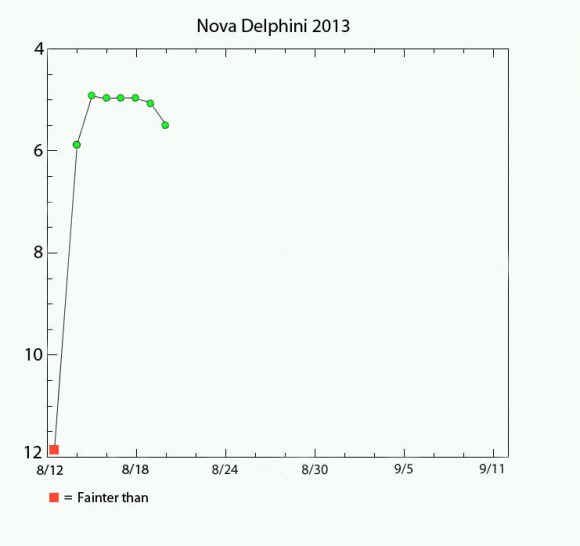
Right away you’ll notice a few interesting things. The nova shot up from approximately 17th magnitude on Aug. 13 to 6.8 on Aug. 14 – a leap of more than 10 magnitudes, which translates to a nearly 10,000 fold increase in brightness.
I wasn’t able to see the Nova Del top out at around 4.4 magnitude – that happened when I was asleep the next morning – but I did catch it at 4.9. The next few days the nova hits a plateau followed by what appears for the moment like a steady decline in brightness. Will it rocket back up or continue to fade? That’s for you and your binoculars to find out the next clear night.
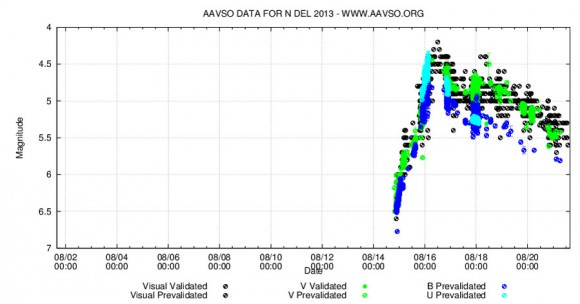
If you’d like to take the next step and contribute your observations for scientific use, head over to the AAVSO (American Assn. of Variable Star Observers) and become a member. Even if you don’t sign up, access to data, charts and light curves of novae and other variable stars is completely free.
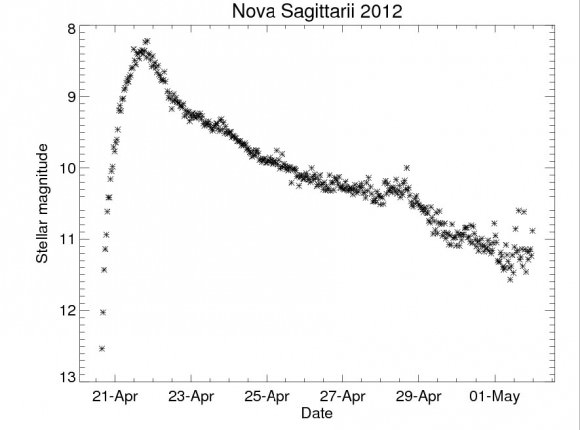
I get a kick out of comparing my basic light curves with those created with thousands of observations contributed by hundreds of observers. The basic AAVSO curve looks all scrunched up for the moment because their time scale (x-axis) is much longer term than in my simple example. But guess what? You can change the scale using their light curve generator and open up the view a little more as I did in the curve above.

Here are a couple other typical novae light curves. By the time you’re done looking at the examples here as well as creating your own, you’ll gain a familiarity that may surprise you. Not only will be able to interpret trends in Nova Delphini’s brightness, but you’ll better understand the behavior of other variable stars at a glance. It’s as easy as connecting the dots.
Don’t Panic: How Space Emergency Astronaut Training Works
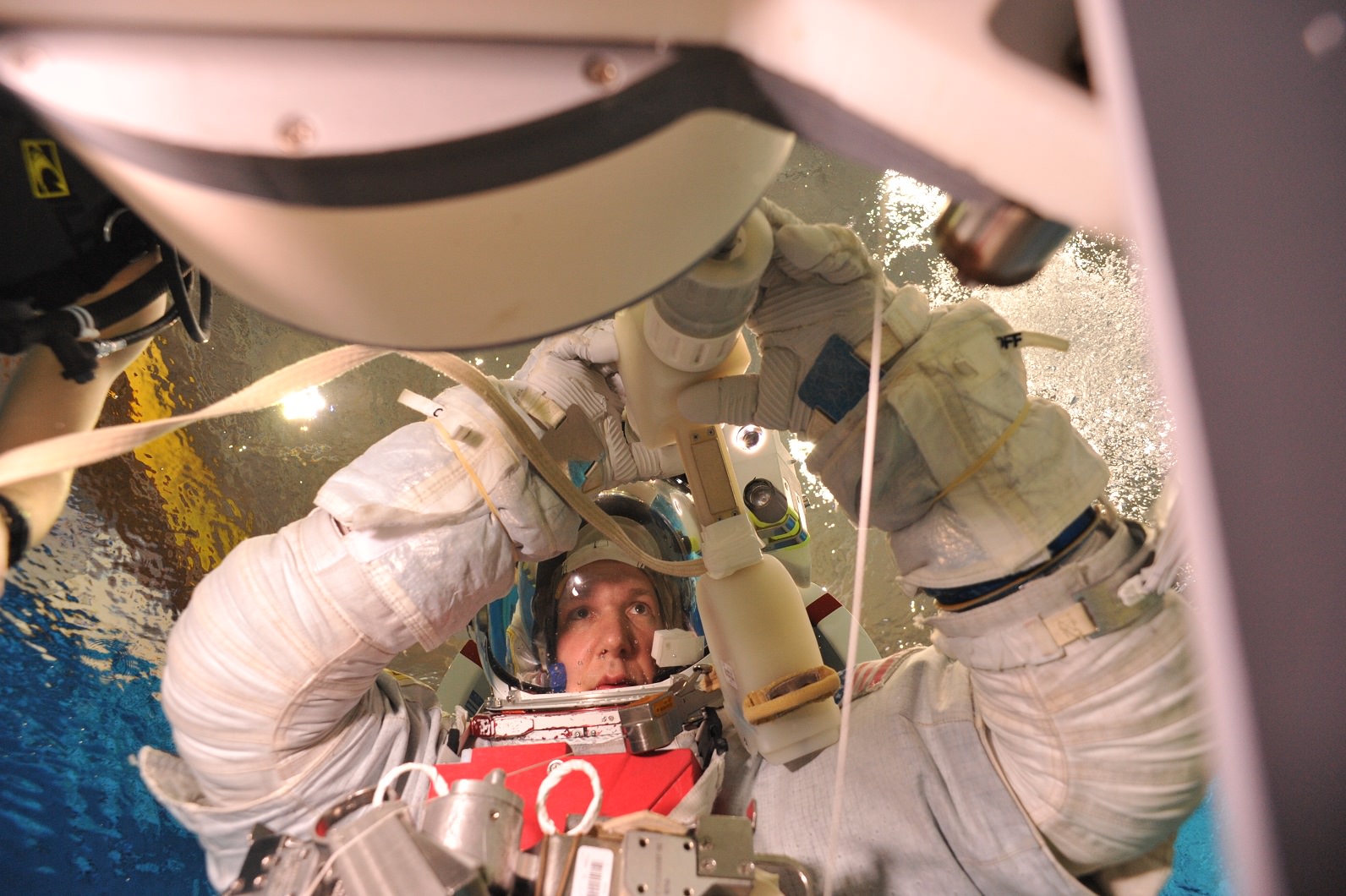
Routines. They tell you when to get up in the morning, what to do at your day job and how to handle myriad tasks ranging from house cleaning to using a computer. Memorizing these procedures makes it a lot easier to handle things that come up in life.
In space, establishing routines is even more important because they will help guide your thinking during an emergency. That’s why astronauts spend thousands of hours learning, simulating and memorizing before heading up to space.
European Space Agency astronaut Alexander Gerst, who will fly to the International Space Station in 2014 during Expedition 40/41, gave Universe Today some insight on how it’s done.
Why train so often? According to Gerst, practicing an emergency procedure on the ground makes it easier to think clearly during a situation up in space. An astronaut’s reaction to any problem on station — a fire, a depressurization, toxic air — is to begin with the procedures. “They sink in and become a memorized response or a natural reaction,” he said. In a fire situation, for example, “Immediately when you hear the sound of the alarm, I will grab the nearest gas mask and the nearest emergency book and head to our control post, which is part of the emergency response.” (Chris Cassidy, a former Navy SEAL on station right now, had more to say to Universe Today in March about “muscle memory” during emergencies.)
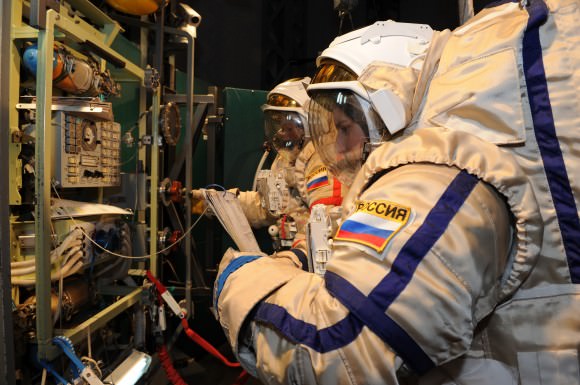
What’s the biggest challenge? The complexity of the station. The American and Russian sides have different procedures and different equipment. There are three types of gas masks on station, for example, and three kinds of fire extinguishing systems. (According to Gerst, all but the most stubborn fires on station are extinguished after cutting ventilation and electricity to the affected area.) To address the complexity, the astronauts spend hours in the classroom discussing what to look for in the fire sensors, pressure sensors, ammonia sensors and other parts of the vehicle. The signatures look different for depressurizations, fires and other conditions in space and it’s key to know what they mean at a glance.
What happens during a simulation? After discussing what actions to take, it’s time to play them out. “We don’t light our modules on fire, but the trainers are creative in creating that [emergency] condition,” Gerst said. Sometimes smoke machines will be used during a fire simulation, for example, or the astronauts will simply be informed by instructors that there is a fire in a section of the station. As the astronauts go through the procedures, trainers keep an eye on them and give feedback. In more complex situations, 10 to 20 flight controllers can join in to simulate communications with Mission Control in Houston or its equivalent in Russia.
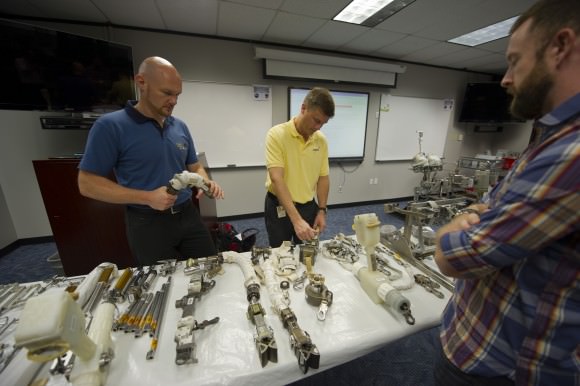
What about dealing with emergencies in a smaller spacecraft? Astronauts can spend anywhere from hours to days on a Russian Soyuz getting to and from the station. If there’s a fire on board, the three people squashed inside the capsule wouldn’t have much room to deploy fire extinguishers. The response is essentially for astronauts to slam shut the visors on their spacesuits and vent the spacecraft. During a depressurization, the procedure is also to close the visor. “You don’t even have to get out of your seat to deal with the emergency, which makes it quite different,” Gerst said.
What about emergencies during a spacewalk? Astronauts spend hundreds of hours inside the Neutral Buoyancy Laboratory in Houston, a huge pool with a mockup of most of the International Space Station inside. They practice spacewalk procedures such as how to bring an unconscious crew member back to the airlock, or what to do if air leaks out of a spacesuit. Gerst credits this sort of training for helping out during a recent incident involving fellow ESA astronaut Luca Parmitano. In July, emergency procedures kicked in for real when Parmitano’s spacesuit sprung a water leak during a spacewalk. In a nutshell, the crew worked to bring Parmitano back inside as quickly as possible, which led to a safe (but early) end to the work. (Read Parmitano’s nail-biting first-hand account of the incident here.)
What’s the big takeaway? Gerst emphasizes that emergency training is a “huge topic”. He and Reid Wiseman recently got checked out for emergency procedures on the United States side of the station, only to fly to Moscow and then have to do the same thing for the Russian side in mid-August. And there’s other training to do as well — another huge topic is medical emergencies , which Gerst practiced in a German hospital in July.
Astronaut Luca Parmitano’s Chilling First-Hand Account of His Mishap in Space
On July 16, Expedition 36 astronauts Chris Cassidy and Luca Parmitano had to cut a planned 7-hour spacewalk short after only an hour and a half due to a malfunction in Parmitano’s space suit, leaking water into his helmet and eventually cutting off his vision, hearing, and communications. Fortunately the Italian test pilot was able to safely return inside the ISS, but for several minutes he was faced with a pretty frightening situation: stuck outside Space Station with his head in a fishbowl that was rapidly filling with water.
On August 20, he shared his personal account of the event on his ESA blog.
“The only idea I can think of is to open the safety valve by my left ear: if I create controlled depressurisation, I should manage to let out some of the water, at least until it freezes through sublimation, which would stop the flow. But making a ‘hole’ in my spacesuit really would be a last resort…”
Parmitano’s description of his suit mishap begins as I’m sure all spacewalks do: with a sense of energy and enthusiasm for a job about to be performed in a challenging yet exotic and undeniably privileged location.
“My eyes are closed as I listen to Chris counting down the atmospheric pressure inside the airlock – it’s close to zero now. But I’m not tired – quite the reverse! I feel fully charged, as if electricity and not blood were running through my veins. I just want to make sure I experience and remember everything. I’m mentally preparing myself to open the door because I will be the first to exit the Station this time round. Maybe it’s just as well that it’s night time: at least there won’t be anything to distract me.”
But even though the EVA initially progressed as planned — ahead of schedule, in fact — it soon became obvious to Parmitano that something was amiss with his suit.
“The unexpected sensation of water at the back of my neck surprises me – and I’m in a place where I’d rather not be surprised. I move my head from side to side, confirming my first impression, and with superhuman effort I force myself to inform Houston of what I can feel, knowing that it could signal the end of this EVA.”
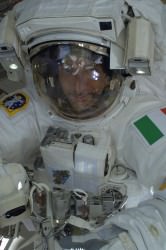
It didn’t take long before an uncomfortable situation escalated into something potentially very dangerous.
“As I move back along my route towards the airlock, I become more and more certain that the water is increasing. I feel it covering the sponge on my earphones and I wonder whether I’ll lose audio contact. The water has also almost completely covered the front of my visor, sticking to it and obscuring my vision. I realise that to get over one of the antennae on my route I will have to move my body into a vertical position, also in order for my safety cable to rewind normally. At that moment, as I turn ‘upside-down’, two things happen: the Sun sets, and my ability to see – already compromised by the water – completely vanishes, making my eyes useless; but worse than that, the water covers my nose – a really awful sensation that I make worse by my vain attempts to move the water by shaking my head. By now, the upper part of the helmet is full of water and I can’t even be sure that the next time I breathe I will fill my lungs with air and not liquid. To make matters worse, I realise that I can’t even understand which direction I should head in to get back to the airlock. I can’t see more than a few centimetres in front of me, not even enough to make out the handles we use to move around the Station.”
After contemplating opening a hole in his helmet to let out some of the water — a “last resort,” indeed — Parmitano managed to get back inside the airlock with help from Cassidy. But he still had to deal with the process of repressurization, which itself takes a few minutes.
Read more: Space Water Leak Prompts NASA Mishap Investigation
“I try to move as little as possible to avoid moving the water inside my helmet. I keep giving information on my health, saying that I’m ok and that repressurization can continue. Now that we are repressurizing, I know that if the water does overwhelm me I can always open the helmet. I’ll probably lose consciousness, but in any case that would be better than drowning inside the helmet.”
Now, a month after the mishap, Parmitano reflects on the nature of the event and of space travel in general.
“Space is a harsh, inhospitable frontier and we are explorers, not colonisers. The skills of our engineers and the technology surrounding us make things appear simple when they are not, and perhaps we forget this sometimes.”
“Better not to forget,” he advises.
Read Luca’s full blog post on the ESA site here.
ESA astronaut Luca Parmitano is the first of ESA’s new generation of astronauts to fly into space. Luca will serve as flight engineer on the Station for Expeditions 36 and 37. He qualified as a European astronaut and was proposed by Italy’s ASI space agency for this mission.
New Astronaut Candidates Speak of Career Change Sacrifices … and Excitement
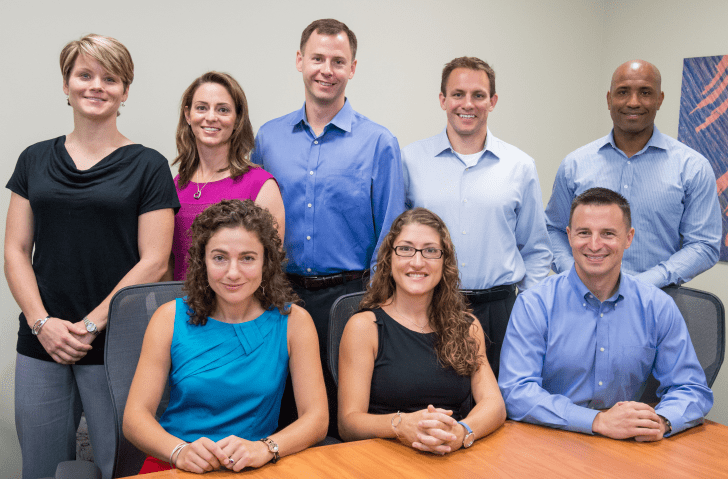
Being selected to (potentially) go on a mission outside of Earth orbit has to be exciting. Assuming the astronaut title, however, brings some tough career choices.
“It’s truly starting at square one,” said Anne McClain, a major in the U.S. Army. She spoke in a televised press conference today (Tuesday) introducing NASA’s newest class of astronaut candidates to the media.
“All of us were in our careers, and we were really in places where we started to be leaders in those careers. Now, our biggest responsibility is to learn from all these people around us, and from years and years of history at NASA so that when that baton does get passed to us, we’re ready to move forward.”
It was the first time NASA’s astronaut candidates — eight Americans, comprising four men and four women — spoke to journalists since their selection. NASA has been heavily promoting this group on Facebook, Twitter and other forms of social media, positioning these new employees in tune with the agency’s desire to retrieve asteroids and generally push on to exploration outside of Earth’s orbit.
The astronauts emphasized the years of effort it took to get to their positions today, with McClain adding it’s best to choose a career you’re passionate about just in case the odds aren’t in your favor. (To put this in perspective, the eight people selected were from more than 6,000 applicants, pegging anyone’s chance of getting in at far less than 1%).
Nevertheless, many of them have been working at it since childhood. Andrew Morgan, also a U.S. Army major, recalled writing to Apollo astronaut Alan Bean when Morgan was in fourth grade (making him about eight or nine years old at the time).
“I received several weeks later a letter in the mail. It was addressed from NASA and I was convinced that that was my acceptance as an astronaut candidate,” Morgan said as laughter came from the audience. “From that day forward, if I had to peg a point, it was that point. It was a letter from Alan Bean that made that difference for me.”

Getting selected was an 18-month process. From the thousands of applications, the top 120 were selected for initial interviews and medical screening and then brought down to a shortlist of 49 that had more detailed evaluations (including team-building exercises).
It was serious work, but there was time for a little fun along the way.
“We were asked to compose a tweet, a limerick or a haiku,” said Victor Glover (a lieutenant-commander in the U.S. Navy) of one writing test during the selection process. His, a limerick, poked fun at the extensive medical testing:
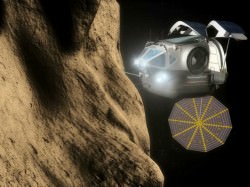
Eyes fixed, gazing off into space
My mind in awe of the human race
This is all dizzying to me
Because I gave so much blood and pee
Happy to be here (at) the colonoscopy place.
We won’t hear much from the astronaut candidates in the next two years as they learn the basics about how the space station works and undergo basic or supplemental flight training in T-38s. In the meantime, you can read more about the candidates on this NASA web hub.
Want to be a government astronaut yourself? Here are some sample guidelines from NASA, the Canadian Space Agency, the European Space Agency and the Japanese Aerospace Exploration Agency. Other active astronaut programs include China and Russia.

